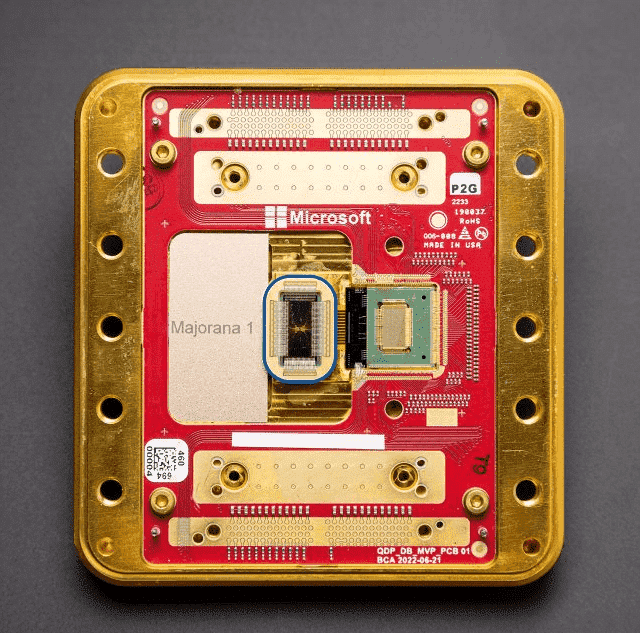Introduction
Quantum computing has long been touted as the future of computing. It is promising to solve problems that are infeasible for classical computers. However, one of the biggest challenges in building a practical quantum computer is error correction. Traditional qubits namely superconducting qubits are used by IBM and Google. However, they are highly sensitive to environmental noise. That leads to frequent errors. This is where Microsoft’s Majorana 1 chip stands out.
At the core of Majorana 1 is a revolutionary approach: topological quantum computing using Majorana fermions. Majorana fermions are elusive particles that were first theorized by physicist Ettore Majorana in 1937. Unlike conventional qubits, Majorana-based qubits are inherently more stable and resistant to decoherence. That makes them ideal for building a fault-tolerant quantum computer.
Microsoft has been working on Majorana-based quantum computing for over a decade. The release of Majorana 1 marks a major breakthrough in this field. Microsoft successfully demonstrated Majorana zero modes (MZMs) and their ability to encode quantum information more reliably. Microsoft aims to pave the way for scalable and commercially viable quantum computing.
In this blog post, we will explore the science behind Majorana fermions and the working principles of Majorana 1. Further, let us cover its potential to transform the landscape of quantum computing.
What Are Majorana Fermions?
Majorana fermions are exotic particles first proposed by Italian physicist Ettore Majorana in 1937. Unlike most known particles, Majorana fermions have distinct counterparts in the form of antiparticles. Majorana fermions are unique because they are their own antiparticles. This means that when a Majorana fermion meets another of its kind, they annihilate each other.
Theoretical Background
In particle physics, most fermions (such as electrons, protons, and neutrons) follow Dirac’s theory. Dirac’s theory states that every particle has a corresponding antiparticle. However, Majorana’s theory suggested that certain neutral fermions could exist as self-conjugated states. That means they do not have a separate antiparticle.
For decades, Majorana fermions remained a purely theoretical concept. However, interest in them grew when researchers realized their potential applications in condensed matter physics and quantum computing.
Majorana Fermions in Condensed Matter Physics
Majorana fermions have not been observed as fundamental particles in nature. Physicists have found evidence of Majorana-like quasiparticles in certain materials. That is particularly true in superconductors. These are called Majorana zero modes (MZMs)—localized quantum states that exhibit the same properties as Majorana fermions.
MZMs appear at the edges of special superconducting nanowires. At where they form topologically protected states. This makes them highly resistant to external disturbances. High resistance to external disturbance is a property that is essential for building fault-tolerant quantum computers.
Why Are Majorana Fermions Important for Quantum Computing?
- Topological Protection: Majorana-based qubits are naturally shielded from many types of quantum noise. That is reducing error rates.
- Non-Abelian Statistics: Unlike regular fermions and bosons, Majorana fermions obey non-Abelian braiding statistics. That allows for unique ways to store and manipulate quantum information.
- Scalability: If harnessed effectively, Majorana qubits could lead to a more stable and scalable quantum computing architecture compared to traditional qubits.
Microsoft’s Majorana 1 chip is built on these principles. Microsoft is aiming to utilize Majorana zero modes for the next generation of quantum computing.
Majorana Fermions in Quantum Computing
Quantum computing relies on qubits. Qubits are the fundamental units of quantum information. However, conventional qubits like superconducting qubits are used by IBM and Google. However, they are highly susceptible to noise and decoherence. That leads to computational errors. This is where Majorana’s fermions come into play. Majorana Fermions offers a promising solution for building more robust and error-resistant quantum systems.
Why Are Majorana Fermions Ideal for Quantum Computing?
Majorana fermions are particularly attractive for quantum computing because they enable the creation of topological qubits. Topological qubits are inherently more stable than traditional qubits. The key advantages of Majorana-based qubits include:
- Topological Protection: Quantum information stored in Majorana fermions is distributed across multiple physical locations. That is making it less prone to local disturbances.
- Non-Abelian Braiding: Unlike regular qubits, Majorana fermions obey non-Abelian statistics. That allows for braiding operations. Braiding operation is a unique method of performing quantum computations that is more resistant to errors.
- Fault-Tolerant Computation: Traditional qubits require extensive error correction. That consumes computational resources. Majorana-based qubits naturally minimize error rates. That is reducing the overhead for error correction.
How Do Majorana Qubits Work?
In a topological quantum computer, pairs of Majorana zero modes (MZMs) are created at the ends of a specially engineered superconducting nanowire. The quantum state of a topological qubit is stored in the collective properties of these MZMs, rather than in a single, vulnerable location.
This unique encoding mechanism makes Majorana qubits inherently robust against small fluctuations in temperature, electromagnetic interference, and material defects. Fluctuations in temperature, electromagnetic interference, and material defects are the factors that typically degrade traditional qubits.
Microsoft’s Role in Majorana-Based Quantum Computing
Microsoft has been at the forefront of Majorana-based quantum research for over a decade. Their approach focuses on:
- Developing Majorana Qubits: Using semiconductor-superconductor hybrid structures to generate and control Majorana zero modes.
- Building the Majorana 1 Chip: A crucial step toward practical topological quantum computing.
- Integrating with Azure Quantum: Microsoft envisions a cloud-based quantum computing platform powered by fault-tolerant Majorana qubits.
The launch of Majorana 1 represents a significant milestone. That is proving that Majorana-based qubits could be the key to unlocking scalable, error-resistant quantum computing.
What is Microsoft’s Majorana 1?
Microsoft has been working on a unique approach to quantum computing for over a decade. That is focusing on topological qubits powered by Majorana fermions. The Majorana 1 chip is the company’s first prototype designed to demonstrate the viability of Majorana zero modes (MZMs) in quantum computing.
An Overview of the Majorana 1 Chip
Majorana 1 is a topological quantum processor that aims to overcome one of the biggest challenges in quantum computing—error correction. Traditional qubits like superconducting qubits used by IBM and Google require extensive error correction mechanisms due to their high susceptibility to decoherence. Microsoft’s Majorana-based qubits, leverage a fundamentally different approach that makes them more stable and resilient.
This chip is designed to generate and manipulate Majorana zero modes. Those Majorana zero modes are essential for encoding quantum information in a way that is naturally resistant to external disturbances. Microsoft utilizes these unique quantum states. It hopes to build a fault-tolerant quantum computer that can scale efficiently with the help of Majorana zero modes.
How Majorana 1 Fits into Microsoft’s Quantum Computing Roadmap
Microsoft’s quantum computing strategy is distinct from other major players in the field. Companies like IBM, Google, and Rigetti focus on superconducting qubits. However, Microsoft has taken a long-term approach. Microsoft is investing heavily in topological quantum computing. The release of Majorana 1 is a key milestone in this roadmap.
Microsoft envisions a quantum computing ecosystem built on Azure Quantum. Azure is its cloud-based quantum platform. If successful, the Majorana-based quantum system will integrate seamlessly with Azure Quantum. Successful integration can offer a stable and scalable computing solution. The company’s strategy consists of:
- Proving Majorana Zero Modes Exist – Microsoft spent years developing specialized materials and nanowires to generate and stabilize Majorana zero modes (MZMs).
- Developing Majorana-Based Qubits – Majorana 1 is the first chip designed to test the feasibility of using MZMs for quantum computing.
- Scaling Toward a Fault-Tolerant Quantum Computer – The ultimate goal is to build a large-scale, error-resistant quantum computer. That quantum computer can solve problems beyond the reach of classical machines.
The Role of Majorana Zero Modes (MZMs) in Enabling Stable Qubits
The foundation of Microsoft’s Majorana 1 chip lies in Majorana zero modes (MZMs). Majorana zero modes are specialized quantum states that emerge at the ends of topological superconductors. These modes possess unique properties that make them ideal for quantum computing:
- Topological Protection: Unlike traditional qubits, quantum information in Majorana qubits is stored non-locally. That makes them less sensitive to environmental noise.
- Braiding Operations: MZMs allow for a unique method of quantum computation called braiding. Braiding is inherently more robust against errors.
- Lower Error Rates: Majorana-based qubits are naturally more stable. Therefore, they require significantly less error correction compared to other qubit technologies.
The successful implementation of Majorana-based qubits in Majorana 1 could pave the way for the world’s first truly fault-tolerant quantum computer. Majorrana 1 can be a game-changer in fields like cryptography, material science, and artificial intelligence.
How Does Majorana 1 Work?
Quantum computing has made significant strides. However, one of its biggest challenges remains error correction. Traditional qubits—like superconducting qubits (IBM, Google) and trapped ion qubits (IonQ)—are highly susceptible to decoherence. Therefore, they require extensive error correction mechanisms. Microsoft’s Majorana 1 chip takes a fundamentally different approach by leveraging topological quantum computing. It promises intrinsic fault tolerance through the unique properties of Majorana fermions.
Topological Quantum Computing: Why It Matters
Topological quantum computing is an advanced approach. Topological quantum computing encodes quantum information in the collective states of Majorana fermions, rather than in single physical particles. This offers a major advantage over traditional qubits:
- Enhanced Stability – Information is stored non-locally. That is making it less susceptible to environmental noise.
- Topological Protection – Computations are performed by braiding Majorana zero modes (MZMs). They are naturally resistant to errors.
- Fewer Error Correction Overheads – Unlike superconducting and trapped ion qubits, Majorana qubits require minimal error correction. Minimal error correction requirement makes them more scalable.
How Majorana Fermions Enable Error-Resistant Quantum States
The core innovation behind Majorana 1 lies in its use of Majorana fermions. Majorana fermions are special quantum particles that act as their own antiparticles. In a topological quantum processor like Majorana 1, pairs of Majorana zero modes (MZMs) are created at the edges of a superconductor-semiconductor hybrid nanowire.
These MZMs encode quantum information in a highly robust manner:
- Non-Abelian Statistics – When MZMs are braided (exchanged in a specific sequence), they manipulate quantum states in a way that naturally preserves information.
- Decentralized Quantum Storage – The quantum state is split between two MZMs. That makes it immune to local disturbances like temperature fluctuations or electromagnetic interference.
- Error-Resistant Qubits – Because the system is inherently stable, quantum errors occur far less frequently. That reduces the need for complex error correction algorithms.
Majorana 1 vs. Traditional Qubit Technologies
| Feature | Majorana 1 (Topological Qubits) | Superconducting Qubits (IBM, Google) | Trapped Ion Qubits (IonQ) |
| Error Resistance | High (intrinsic fault tolerance) | Low (requires extensive error correction) | Medium (moderate error correction needed) |
| Qubit Stability | High (protected by topology) | Low (prone to decoherence) | Medium (better than superconducting) |
| Scalability | High (fewer qubits needed) | Low (millions of qubits required) | Medium (challenging for large systems) |
| Computation Speed | Fast (braiding-based logic) | Medium (gate-based logic) | Slow (ion movement limits speed) |
| Technology Maturity | Early-stage research | Commercially available | Some commercial applications |
In superconducting quantum experiments and early applications trapped ion qubits are already being used. Their error rates significantly limit their scalability. Microsoft’s Majorana 1 chip could revolutionize the field by offering a naturally error-resistant quantum computing solution if it is successful.
The Majorana 1 Breakthrough: Why It is a Game-Changer
Microsoft’s Majorana 1 chip represents a monumental step forward in the quest for a scalable, fault-tolerant quantum computer. Traditional quantum systems struggle with error correction and decoherence. However, Majorana-based qubits promise unparalleled stability and lower error rates. The successful detection and control of Majorana fermions within this chip marks a turning point in quantum computing research.
The First Experimental Success in Detecting and Controlling Majorana Fermions
For years, physicists have theorized about Majorana zero modes (MZMs). Majorana zero modes are exotic quantum states that could be used to build inherently stable qubits. However, proving their existence and controlling them in a practical system remained a major challenge.
With Majorana 1, Microsoft has achieved a significant breakthrough:
- Controlled Creation of MZMs – The chip successfully generates Majorana zero modes within a superconductor-semiconductor nanowire.
- Stable Quantum States – The Majorana-based qubits exhibit resilience against environmental disturbances. A stable quantum state is a key requirement for practical quantum computing.
- Braiding Operations – Microsoft has demonstrated the feasibility of braiding Majorana zero modes. Braiding is a fundamental mechanism required for topological quantum computing.
This breakthrough validates Microsoft’s long-term approach to topological quantum computing. It sets the stage for the development of a truly fault-tolerant quantum processor.
Advantages Over Conventional Qubits
Microsoft’s Majorana-based qubits offer significant advantages over traditional superconducting and trapped-ion qubits:
✅ Enhanced Stability
- Traditional qubits are extremely sensitive to noise. They require millions of qubits and error correction codes to maintain computational integrity.
- Majorana-based qubits, by contrast, are inherently stable. That is drastically reducing the need for external error correction.
✅ Lower Error Rates
- Superconducting qubits (IBM, Google) suffer from high decoherence, meaning their quantum states decay quickly.
- Trapped ion qubits (IonQ) are more stable but require precise laser controls. That is making them difficult to scale.
- Majorana qubits store information in topological states. They are naturally immune to minor environmental fluctuations. That is leading to lower error rates.
✅ Scalability & Efficiency
- Superconducting qubits require millions of qubits for fault tolerance, which poses huge engineering challenges.
- Majorana-based qubits can achieve fault tolerance with far fewer physical qubits. That makes them much more scalable for real-world applications.
Microsoft’s Quantum Program and the Azure Quantum Initiative
Microsoft has been betting big on topological quantum computing as a long-term strategy. Unlike competitors like IBM, Google, and Rigetti, which focus on superconducting qubits, Microsoft has taken a more fundamental physics approach. That is working to develop a more stable quantum platform from the ground up.
Their quantum roadmap includes the following:
- Majorana 1 Chip Development – The first major step toward a functional topological quantum processor.
- Scaling Majorana-Based Qubits – Microsoft aims to increase the number of Majorana qubits while maintaining stability.
- Azure Quantum Integration – Once operational, Majorana-based quantum computing will integrate with Azure Quantum. Azure is Microsoft’s cloud-based quantum platform.
What This Means for the Future
If Microsoft succeeds in scaling Majorana-based qubits, it could lead to:
✔ More powerful quantum computing applications in cryptography, drug discovery, and AI.
✔ Cloud-based quantum services via Azure Quantum are possible. That is making quantum computing accessible to businesses.
✔ A paradigm shift away from error-prone superconducting qubits to naturally fault-tolerant quantum computing.
The Majorana 1 breakthrough is not just another step—it is a potential game-changer that could redefine the future of quantum computing.
Challenges and Future Prospects
Microsoft’s Majorana 1 chip represents a significant leap toward fault-tolerant quantum computing. However, several challenges must be addressed before it becomes a viable technology. From stabilizing Majorana zero modes (MZMs) to scaling the system for real-world applications, the road ahead is filled with both scientific and engineering hurdles.
The Experimental Challenges of Majorana-Based Qubits
One of the biggest difficulties in leveraging Majorana fermions for quantum computing is creating and stabilizing Majorana zero modes (MZMs) in a controlled environment. The conditions required for MZMs to emerge are extremely delicate:
- Ultra-Low Temperatures – Majorana 1 operates at temperatures close to absolute zero using dilution refrigerators. That is making large-scale deployment challenging.
- Precise Material Engineering – The topological properties needed for MZMs require highly specialized superconductor-semiconductor hybrid materials. These materials are very difficult to fabricate reliably.
- Error-Free Braiding Operations –Majorana qubits are theoretically robust. However, achieving perfect braiding operations in practice remains an experimental challenge.
The Debate Over Majorana Evidence
Although Microsoft’s research has made headlines, the scientific community remains divided on whether the observed Majorana zero modes are truly the robust, non-Abelian states needed for quantum computing.
- In 2018, Microsoft published a breakthrough study claiming the successful detection of Majorana fermions.
- However, in 2021, researchers found inconsistencies in the data. That led Microsoft to retract the original paper.
- Since then, the company has refined its approach, with the Majorana 1 chip serving as the latest step toward definitive proof of topological qubits.
Despite the skepticism, the race for Majorana-based quantum computing is far from over. If successful, it could surpass other quantum approaches in stability and scalability.
What is Next? Microsoft’s Long-Term Quantum Vision
Microsoft’s ultimate goal is to develop a fully fault-tolerant quantum computer that integrates seamlessly with Azure Quantum. Azure is its cloud-based quantum computing platform. The roadmap includes:
- Proving Large-Scale Majorana Qubit Arrays – Demonstrating that Majorana-based qubits can function reliably in larger quantum circuits.
- Building Scalable Quantum Hardware – Moving beyond experimental prototypes to practical quantum processors.
- Integrating Quantum Computing with Azure – Providing quantum computing power through Azure Quantum. That allows industries to solve complex problems in cryptography, materials science, and AI.
A Promising but Uncertain Future
Microsoft’s Majorana 1 chip represents a bold attempt to redefine quantum computing by eliminating the need for excessive error correction. However, scientific validation, hardware challenges, and scalability concerns must be addressed before it can compete with other quantum computing technologies.
If Majorana-based qubits prove to be as stable and scalable as predicted then they could unlock the era of practical, fault-tolerant quantum computing. That could be something that remains elusive with today’s qubit technologies.
Conclusion: The Future of Quantum Computing with Majorana 1
Microsoft’s Majorana 1 chip represents a bold step toward solving one of quantum computing’s greatest challenges: error correction. By leveraging Majorana fermions and topological qubits, this approach could redefine the quantum computing landscape. This approach makes quantum processors inherently more stable and scalable.
If successful, Majorana-based quantum computing could:
- Reduce error rates, making computations more reliable.
- Scale more efficiently, overcoming the limitations of traditional qubits.
- Accelerate breakthroughs in AI, cryptography, and materials science.
Microsoft’s Position in the Quantum Race
While companies like Google and IBM focus on superconducting qubits, and IonQ advances trapped ion qubits, Microsoft’s topological approach sets it apart. By prioritizing fault tolerance from the ground up, Microsoft aims to leapfrog competitors once Majorana qubits are fully realized.
With its Azure Quantum platform, Microsoft is positioning itself as a leader in cloud-based quantum computing. This ensures businesses and researchers can access quantum power as soon as it becomes commercially viable.
What This Means for the Future
If Majorana-based quantum computing reaches its full potential then it could revolutionize multiple fields:
- Cryptography – Breaking today’s encryption methods while also enabling new quantum-resistant security techniques.
- AI & Machine Learning – Accelerating AI model training and optimization with unprecedented computing power.
- Computational Science – Simulating complex molecules for drug discovery, climate modeling, and new materials research.
Final Thoughts
Majorana 1 is still in the experimental stage. It represents one of the most exciting developments in quantum computing. If Microsoft can overcome the challenges of validation, stability, and scalability then it could usher in a new era of fault-tolerant quantum computing. That can bring us closer to solving problems that are currently beyond the reach of classical computers.
The next few years will be crucial in determining whether Majorana qubits can fulfill their promise. However, if they do, the impact could be nothing short of revolutionary.







